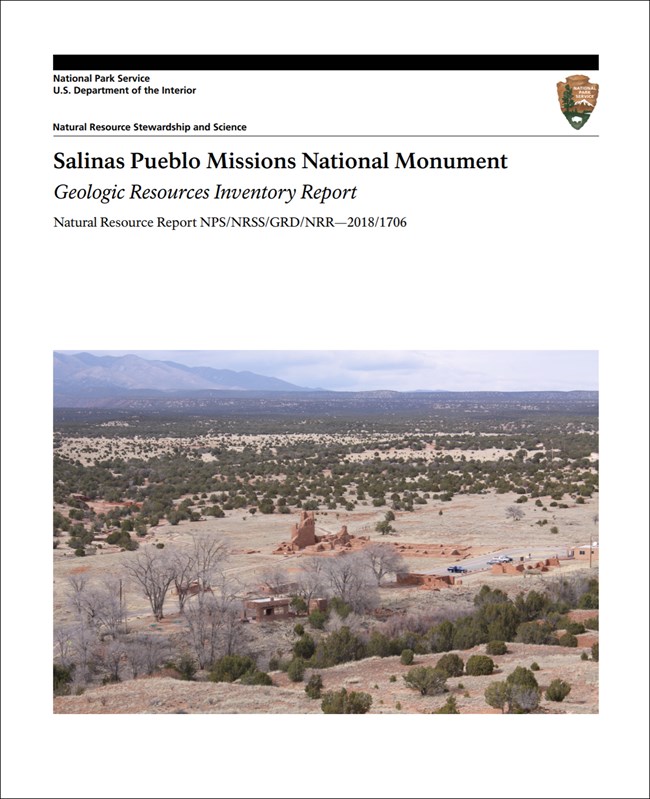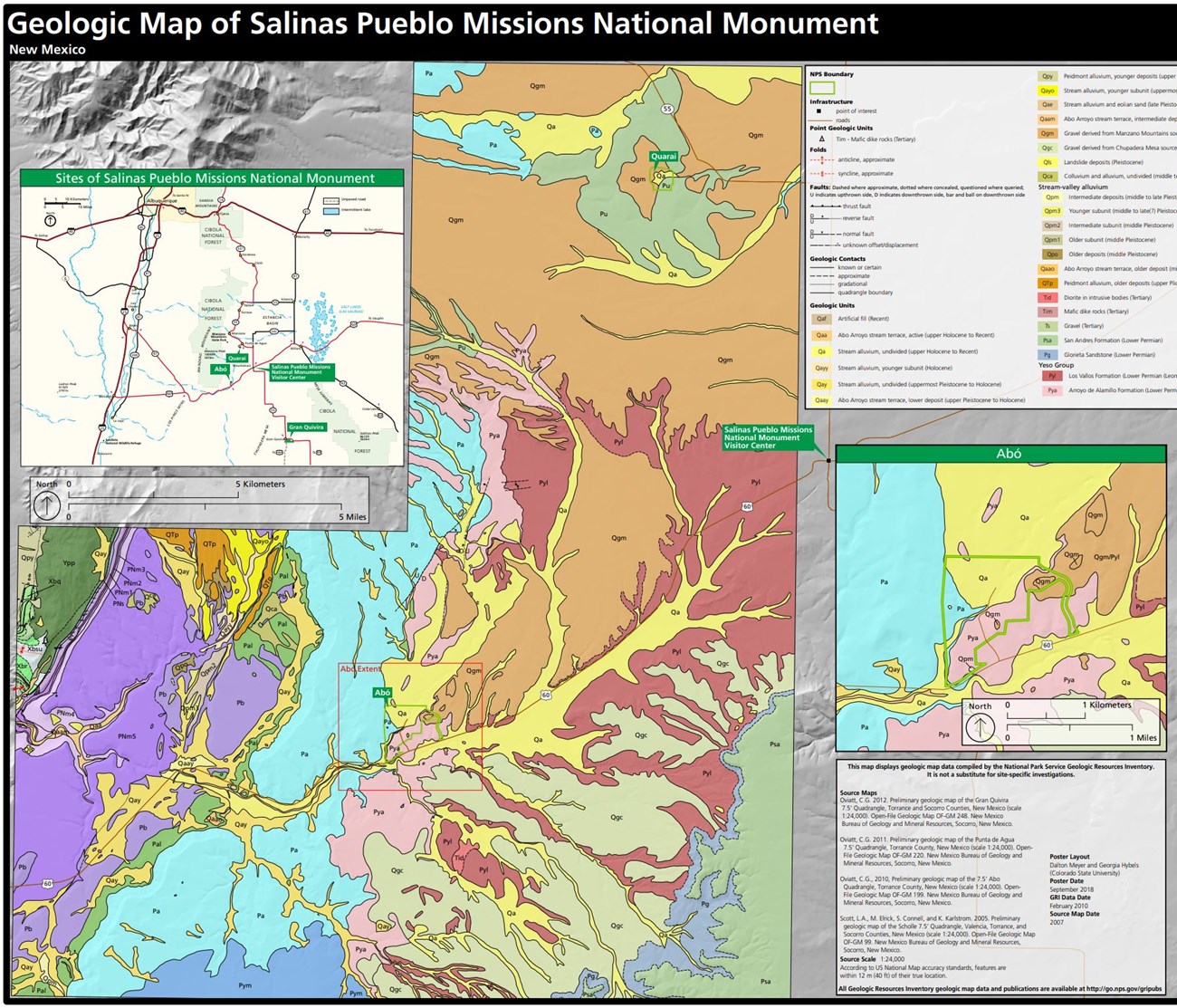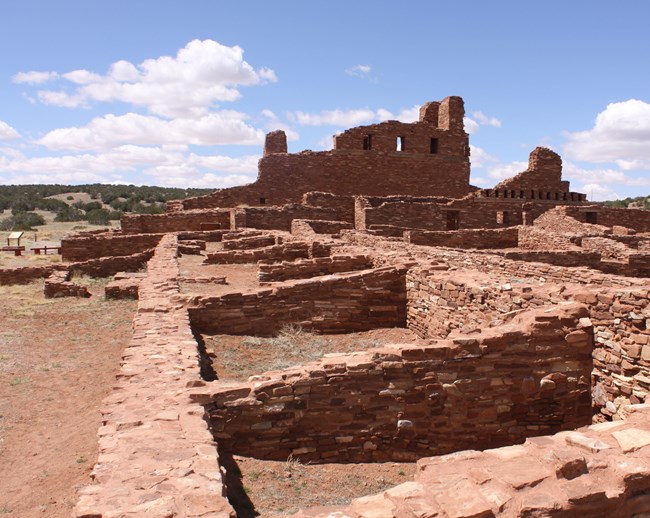Last updated: July 16, 2024
Article
NPS Geodiversity Atlas—Salinas Pueblo Missions National Monument, New Mexico
Geodiversity refers to the full variety of natural geologic (rocks, minerals, sediments, fossils, landforms, and physical processes) and soil resources and processes that occur in the park. A product of the Geologic Resources Inventory, the NPS Geodiversity Atlas delivers information in support of education, Geoconservation, and integrated management of living (biotic) and non-living (abiotic) components of the ecosystem.

Introduction
Salinas Pueblo Missions National Monument is located about 80 km (50 mi) southeast of Albuquerque and consists of three non-contiguous units (Abó, Gran Quivira, and Quarai) in Socorro and Torrance Counties, central New Mexico. Originally authorized as Gran Quivira National Monument on November 1, 1909, the monument was expanded and later renamed Salinas National Monument in 1980 before its current name was established on October 28, 1988. The national monument contains approximately 433 hectares (1,071 acres) and preserves three Puebloan villages, four of the best-preserved 17th century Spanish mission churches in the United States, and 19th and 20th century rancheros. The largely unexcavated sites at Abó, Gran Quivira, and Quarai are part of an expansive regional complex of early to late pueblo history sites interwoven with Archaic history, trade routes, and a long-standing tradition of cultural diversity.
Geologic Setting
The regional geologic setting of Salinas Pueblo Missions National Monument encompasses the Rio Grande Rift, Manzano Mountains, Estancia Basin, and Chupadera Mesa (KellerLynn 2018). Mapped units throughout the monument include Permian-age sedimentary rocks of the Abo, Arroyo de Alamillo, and San Andres Formations, Tertiary igneous dikes, and Quaternary stream alluvium and eolian sand deposits. The colorful Permian “red beds” consist of red, orange, yellow, and pinkish white sandstone and mudstone interbedded with gray limestone, sandstone, and gypsum. Pueblos and churches in Salinas Pueblo Missions were predominantly built from these Permian-age red sandstones and gray limestones. At the Gran Quivira unit, Tertiary mafic igneous dikes intrude Permian strata of the Chupadera Mesa, deforming the overlying layers into many small anticlinal structures that the pueblo and mission were constructed upon.
Regional Geology
Salinas Pueblo Missions National Monument is a part of the Basin and Range Physiographic Province and shares its geologic history and some characteristic geologic formations with a region that extends well beyond park boundaries.
- Scoping summaries are records of scoping meetings where NPS staff and local geologists determined the park’s geologic mapping plan and what content should be included in the report.
- Digital geologic maps include files for viewing in GIS software, a guide to using the data, and a document with ancillary map information. Newer products also include data viewable in Google Earth and online map services.
- Reports use the maps to discuss the park’s setting and significance, notable geologic features and processes, geologic resource management issues, and geologic history.
- Posters are a static view of the GIS data in PDF format. Newer posters include aerial imagery or shaded relief and other park information. They are also included with the reports.
- Projects list basic information about the program and all products available for a park.
Source: NPS DataStore Saved Search 3164. To search for additional information, visit the NPS DataStore.
A NPS Soil Resources Inventory project has been completed for Salinas Pueblo Missions National Monument and can be found on the NPS Data Store.
Source: NPS DataStore Saved Search 3115. To search for additional information, visit the NPS DataStore.
GRI Geology Image Gallery
Related Articles
Salinas Pueblo Missions National MonumentNational Park Service Geodiversity Atlas
The servicewide Geodiversity Atlas provides information on geoheritage and geodiversity resources and values within the National Park System. This information supports science-based geoconservation and interpretation in the NPS, as well as STEM education in schools, museums, and field camps. The NPS Geologic Resources Division and many parks work with National and International geoconservation communities to ensure that NPS abiotic resources are managed using the highest standards and best practices available.


